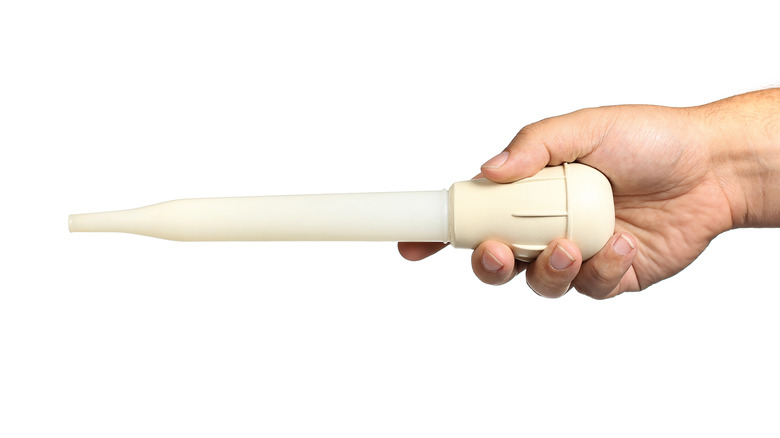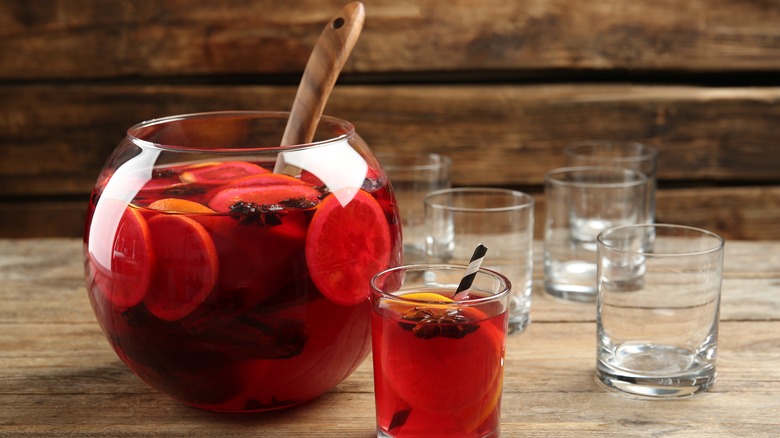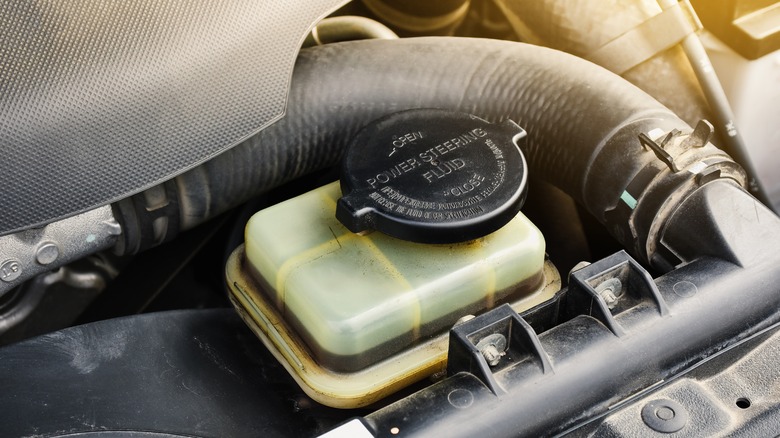A Turkey Baster Is The Tool You Didn't Realize You Needed For Pouring Drinks
You're at a fancy bar — and by fancy, we don't mean someone just put a tablecloth over a booth and some cheap roses in a plastic vase. We're talking so fancy you can't even pronounce some of the wines on the menu. As you sit over your expensive Manhattan or Mai Tai, you notice the bartender refilling drink glasses behind the counter. But instead of using a pitcher, a decanter, or a tumbler, he's using... What is that? Is that a... turkey baster, like the kind you have sitting in your drawer at home? The one you baste your Thanksgiving turkey with?
You're forgiven if you associate turkey basters with cooking a Thanksgiving dinner. Zyliss explains that the turkey baster, or basting bulb, is a popular method for cooking thanks to its ability to absorb and redistribute a lot of liquid. You simply dip the end of the baster into whatever liquid you want, squeeze the rubber bulb to suck up the liquid, and then squeeze the bulb again to spay the liquid out, like some sort of culinary squirt gun. They're not too expensive either, with a basic one selling on Amazon for under $10 dollars, making them a far cry from the elaborate and expensive tools one would normally expect to find in an upscale bar.
Why, then, should you be asked to use something you normally use to baste poultry to serve drinks? What are the benefits of using a turkey baster that you can't get with a pitcher?
Turkey basters help to portion drinks
When you serve drinks, whether it's a bowl of non-alcoholic punch or spiked hot cider, you usually use something like a ladle. These can get a whole lot of liquid in one scoop, but more often than not, they tend to spill some of their contents all over the table. Sometimes, there's even a bit of liquid left in the bowl that's too shallow for the ladle to get, and you usually have to dump it out.
That's why Lifehacker recommends using a turkey baster. Instead of someone trying to lift and move a ladle full of punch or wine across the table, letting it drip all over the other plates and utensils, all one would have to do is simply put the baster into the bowl, squeeze to absorb the liquid, and then squeeze again to refill their cup or glass. Unlike a ladle, many basters are "drip-proof" and, thanks to their usual application of basting oven-hot turkeys with their own juices, they can easily handle warm or hot drinks. It's also useful, Lifehacker explains, because guests who are getting a bit inebriated can easily "pour" themselves a drink without fumbling with a ladle.
But if a turkey baster is good at serving drinks cleanly and easily in the same way it can baste a turkey, are there any other things that this common kitchen tool can do?
You can use basters for everything to car repair to painting
Are you particularly skilled at fixing your car without having to take it to a mechanic? Do you have a garden or flowerbox you're really proud of? Do you plan on getting pregnant any time soon? If you've answered yes to any of these questions, then you may want to turn to the turkey baster.
According to Oil Depot, it's entirely possible to use a turkey baster to change the power steering fluid in your car. Turn the car's engine off and use the baster to draw out as much fluid from the reservoir as you can. Once the old fluid is drained out, use the baster to refill the reservoir with new liquid. You may have to do this a few times, Oil Depot tells us, as the process of draining and refilling helps to remove the old power steering fluid from the engine.
The Huffington Post also tells us that, should you be an avid gardener, it's pretty hard to remove dirty "stale" water from your plants without messing up the soil or disturbing the roots of the plant. Rather than try to drain the water manually, simply "suck up" the dirty water with a turkey baster and then add fresh clean water once the water's removed.
The turkey baster also has somewhat of a "reputation" for "assisting" women in getting pregnant — although URA tells us that this is more of a myth than it is anything serious.


